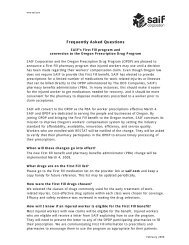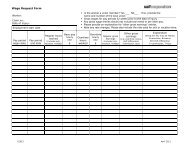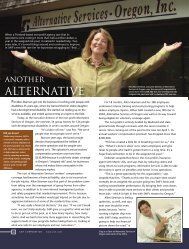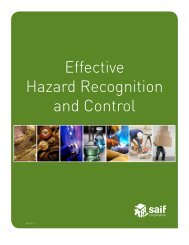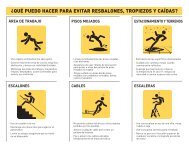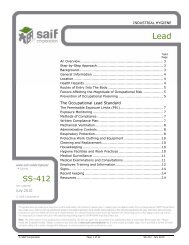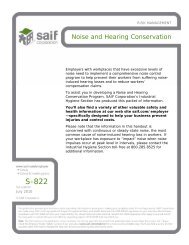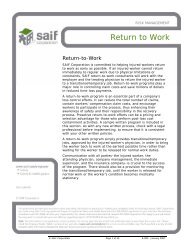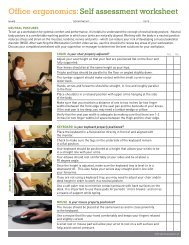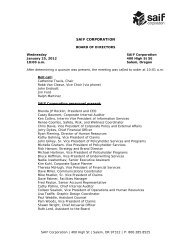Incident/Accident Analysis - SAIF Corporation
Incident/Accident Analysis - SAIF Corporation
Incident/Accident Analysis - SAIF Corporation
Create successful ePaper yourself
Turn your PDF publications into a flip-book with our unique Google optimized e-Paper software.
Conducting an incident/accident analysis<br />
All accidents, incidents, close calls, and near-misses should be analyzed for corrective action regardless of<br />
severity. If practical, the analysis should be completed promptly and at the scene of the incident. Time and<br />
distance from the incident work against a thorough analysis because most people quickly forget important<br />
facts and key visual details.<br />
The <strong>Incident</strong>/<strong>Accident</strong> <strong>Analysis</strong> form should first be completed by the immediate supervisor of those directly<br />
involved in the incident. Managers, safety committee members, the safety coordinator, or an analysis team<br />
can assist in the absence of the immediate supervisor. However, at a minimum, the supervisor should<br />
review the analysis for more fact finding and corrections.<br />
The purpose of the <strong>Incident</strong>/<strong>Accident</strong> <strong>Analysis</strong> form is to prompt the people doing the analysis to ask openended<br />
questions about the various components that may have contributed to the incident. The analysis<br />
explores the four organizational systems: Management, Employee, Equipment, and Environment<br />
(MEEE). The prompts alongside each box are designed to encourage open dialogue and communication<br />
about facts and details.<br />
<strong>Analysis</strong> process<br />
The people conducting the analysis needs to look at the systems, procedures, and policies within the<br />
business that are not working and that may have contributed in some way to the incident. Even minor<br />
contributions should be listed. Only record those items found that are not working. The intent of the analysis<br />
is to discover system failures, so they can be corrected in order to prevent future incidents and accidents.<br />
The analysis<br />
There are four steps to this analysis: fact gathering, system analysis, countermeasures, and monitoring.<br />
You may need more space than provided on the form, so record on another paper if needed.<br />
Step 1: Fact gathering<br />
Move through each section and record facts that contributed to the incident. There is no specific order on the<br />
form. You may find yourself going back and forth between MEEE elements, and you may even have items<br />
that overlap more than one MEEE element because these systems work together at some level. Ask openended<br />
questions such as: How did this happen Tell me what you and others were doing What tools were<br />
you using How were the conditions around you Record findings in the boxes.<br />
Step 2: System analysis<br />
This is a series of “why” questions for each of the facts recorded during Step 1. The key to the system<br />
analysis is in asking “why” questions. It will take you to core system and cultural issues within the<br />
organization. Keep asking “why” to determine what caused or allowed this condition or practice to occur until<br />
you get to the core of the problem. Record your findings in the boxes.<br />
Step 3: Countermeasures<br />
Once the system analysis is complete, it is time to develop solutions or countermeasures. Each item that has<br />
been identified in the spaces should have a corrective action that will be taken. You may find that some items<br />
in one or more of the MEEE boxes are similar or the same, so one solution could be possible for all of those.<br />
You should then identify who you think is responsible to fix this item or implement this solution. Also<br />
determine the time frame in which you think it should be done. Take your best effort at filling in the spaces,<br />
knowing that this information will be reviewed and can be updated or revised as needed.<br />
Step 4: Monitoring<br />
Many times great solutions are developed and implemented only to have things revert back to former<br />
practices. This is because no one followed-up on these new processes to make sure they were used<br />
effectively. All employees are responsible to follow safe work practices, but it is essential for management<br />
and the safety committee to ensure that the countermeasures identified in this analysis are actually used.<br />
This is only an <strong>Incident</strong>/<strong>Accident</strong> <strong>Analysis</strong> form. You will need to complete the workers’ compensation claim form (801) if the injury required medical<br />
treatment beyond first aid. There are also other Oregon record keeping requirements for recording and reporting work-related fatalities, injuries, and<br />
illnesses. Please visit http://www.orosha.org/subjects/recordkeeping.html for additional information on these requirements.<br />
S767 <strong>SAIF</strong> <strong>Corporation</strong> 5/12



